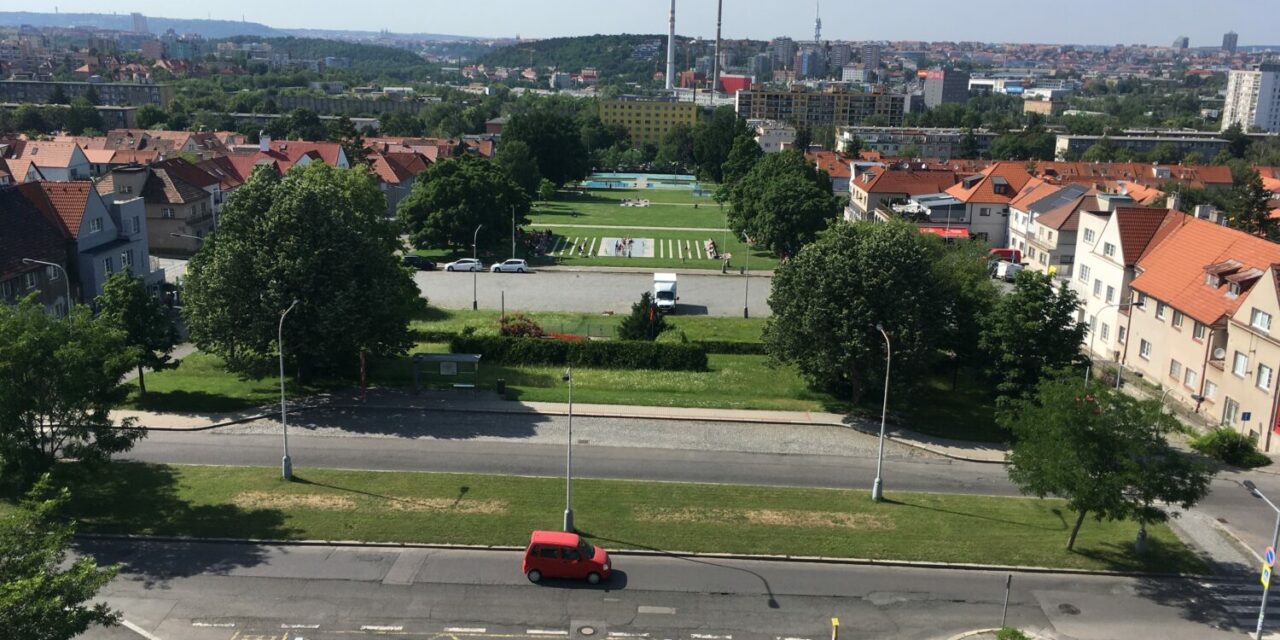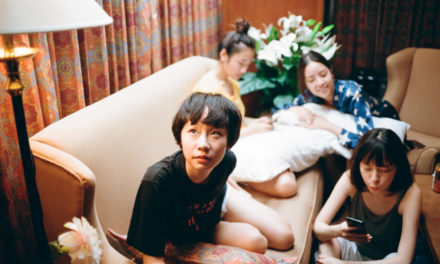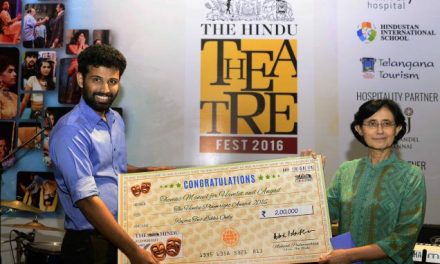Today’s Prague Quadrennial adventures took me further away from the Exhibition Grounds than any site-specific performance yet, and in fact, further from the city center than I normally go. I was taking part in an excursion organized by Praha není Česko (Prague Is Not Bohemia), the award-winning “travel agency” created by the students of the Theatre Academy in Brno to show off the vistas of this city that you can’t see from Charles Bridge. They were taking us on a tour of Spořilov, a vaguely utopian intentional community built on the outskirts of Prague in the 1920s. To get there, I had to take tram 11 all the way to the end of the line. By the second-to-last stop, I was one of four people on board. Then the other three got off, the youngest, a boy of about 12 or 13, smiling at me bemusedly from the platform. I rode to Spořilov in solitude, excited to see what it was all about, but also nervous, because the trip was scheduled to last six hours. Was this performance art, or an architectural dig?
The name of the excursion was “Reality Spořilov,” “reality” in this case meaning “real estate” or “properties.” But the unintentional second meaning works too. For a space designed nearly a hundred years ago as an intentional community to still be functioning, it must be one of two things: a cult, or a place like any other, its idealistic/ideological starting point having receded to the background. Well, Spořilov isn’t a cult. (If only! I can think of at least one fan of socialism, twentieth-century modernism, and the Arts and Crafts movement who would happily join me in signing over our rights…she could serve the community by running the town library…) Because the area’s ethos was expressed through architecture and urban planning, the philosophy of the place is immediately evident. It’s just that all around it is the life of the 21st century: high-tech, late capitalist, and vaguely dystopian.
Side note – if, like me, you’re fascinated by intentional communities, check out Avery Trufelman’s new podcast Nice Try! The first few episodes have covered Jamestown, Chandigarh, and Levittown. Talk about heaven on earth!
Our first stop was at a bar that abuts the tram platform: První Pivní Tramway (First Beer Tramway). There, we met our guides for the day: Frederika, a student at the Theatre Academy and one of the visionaries behind Praha není Česko, was our gal Friday. She handled all the administrative business, plus served as navigator, interpreter, waitress and, until her friend stepped up, cinematographer for the group’s live-stream. Then there were the expert guides: Michal, a puckish Prague scenographer, and Rudy, who took a very serious attitude for what is, at the end of the day, a very funny business. I realized quickly that the reason the trip would stretch out over six hours was that First Beer Tramway was only our First Beer Stop. The excursion included three leisurely visits to bars, which were even more leisurely for Michal and Rudy when they sent Frederika and us suckers off on a little scavenger hunt.
Spořilov is beautiful. A large square, the third biggest in Prague, is its centerpiece, at the top of which stands Kostel svaté Anežky, the Church of Saint Agnes, a tall, simple Catholic church in the style of architectural functionalism built in 1935. The square is green and dotted with fountains in the style of “splash pads,” water shooting straight up out of the ground, providing free summertime recreation for the town’s children. There are eight different designs for houses in the area, which creates a rare effect of simultaneous variety and aesthetic unity. And those eight designs, gosh they’re pretty. The style is typical for early-twentieth-century Prague. Flat, clean facades lacking ornamentation in tones of white and gray, with sloping rust-colored roofs, sometimes small balconies with curved stainless-steel handrails. Often ideologically-motivated design becomes dated as soon as they’re a shift in power, but this is the kind of modernist purism that doesn’t go out of style.
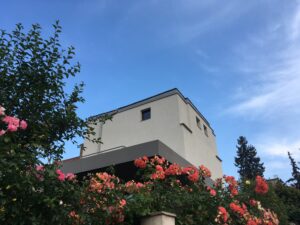
Photo by Abigail Weil
Because we’re a fair distance outside the center, there’s enough space to go around. Prague’s tight medieval streets here grow into wide boulevards, purely for pleasure (when Spořilov was founded, it was frowned upon to own a car for personal use). And what’s really special is that most of the houses have big, lush backyards. Spořilov is what’s known as a “zahradní mesto,” a “garden city,” a model of urban planning that developed in response to increasing industrialization. The philosophy was developed in England by thinkers like Ebenezer Howard and William Morris (“Will Morris,” Michal called him) at the very end of the nineteenth century. In a garden city, recreation, agriculture, industry, and residence exist in visual and social harmony. Spořilov is Prague’s biggest; another is Ořechovka. The people who moved to Spořilov in the 1920s did so on purpose, to be part of this experiment. Today, it’s still desirable real estate, but without the obligations to the community.
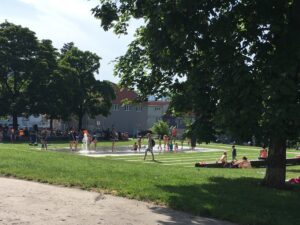
Photo by Abigail Weil
We had a brief orientation in the main square, then visited the lovely Church of Saint Agnes. From the bell tower, we could see the city’s layout, with the centrality of the green square and broad streets radiating outward. During our break at the next bar, Eureka, we were given a task: come up with different combinations of numbers that could be used to enter the state lottery. If we won, we’d have enough to buy a house there in Spořilov. After all the numbers were submitted, we were given maps of available properties. As a group, we went to visit them, and Frederika led us in a discussion of the houses’ various benefits and disadvantages, and what creative use each space could be put to. A small performance space or cinema would be nice but to my mind, there’s no better way to honor the planners of Spořilov than to just live there, harmoniously and industriously.
After our walkabout, we visited the third bar: Svaté Peklo, Holy Hell, which shares space with the Vietnamese restaurant Linh Tasty Asia. (Pro tip: there is a huge Vietnamese population in Prague, so when you visit, don’t overlook this facet of the food culture. It’s as authentic as goulash.) I took my leave early, as the group waited for the lottery numbers to be drawn. I’d spent the day learning about my favorite things – historical modernism, cultish intentional communities, and landscape architecture. I didn’t need any more to feel like a winner.
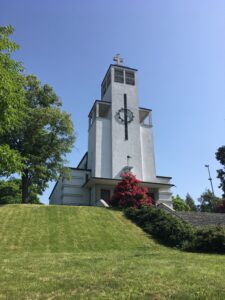
Photo by Abigail Weil
I’m so glad I got the opportunity to visit Spořilov and learn about its history and philosophy. But as I made my way back to Prague, I found I was disturbed by an unanswered question of the Praha není Česko initiative: who was it for? Of our little group that went to Spořilov, half were English-speaking foreigners, and half were Czechs. One, in fact, was from Spořilov, and wanted to learn more about the origins of her hometown. I thought it was really cool that Praha není Česko appealed as much to the locals as to the visitors, but the organizers didn’t seem to think through how to keep everybody engaged. As the day went on (and more beers were consumed), the English-speakers grew more garrulous, while the Czech guests grew more quiet, perhaps out of consideration to Frederika who was working so hard to translate for everyone. Two of the four Czech guests left before the end, slipping away discreetly while the foreigners sprawled conversationally. But at the same time, one of the guides increasingly showed his disdain for 25% of the foreign nationalities represented — the American, myself — to the point where other guests started approaching me to express their sympathy. I mean, I get it, I can be very anti-America myself. But there is always a difference between a country’s government and its people. On the basis of my nationality, I was made to feel very unwelcome. So much for unity.
I understand that Praha není Česko is a travesty of a travel agency, and the whole day was something of a mystification, what with the fake lottery numbers and the scavenger hunt while our guides sipped wine on a shaded patio. And to be fair, the rude guide was not one of the Theatre Faculty students, so technically he doesn’t represent Praha není Česko. But I do hope that the students are thinking through the experience of their multi-national audience. I left at the same time as one of the Czech guests, a bright young architecture student, and as we talked about the experience, I realized that she felt as alienated as I did. If the guides had a good laugh over this bamboozle, well that’s fine, and it fits into the great Czech tradition of elaborate pranks, like the Party for Moderate Progress Within the Limits of the Law, and Jára Cimrman. I only hope that the people declaring that Prague Is Not Bohemia have a good answer to the question, so what is?
This post was written by the author in their personal capacity.The opinions expressed in this article are the author’s own and do not reflect the view of The Theatre Times, their staff or collaborators.
This post was written by Abigail Weil.
The views expressed here belong to the author and do not necessarily reflect our views and opinions.

